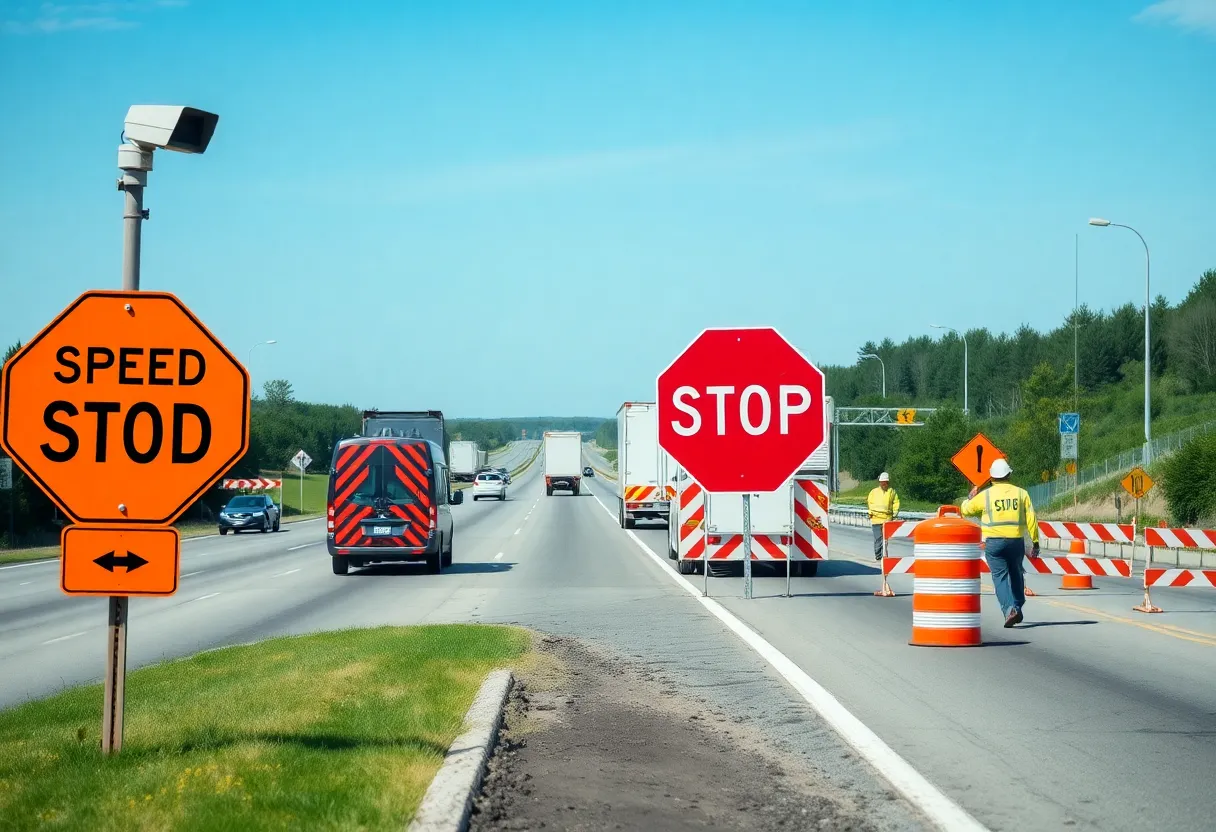Louisville, October 16, 2025
In Kentucky, speed enforcement cameras deployed in work zones have demonstrated a significant 30% reduction in speeding, enhancing safety for workers and drivers. The automated system, which issues $50 fines for exceeding speed limits by 15 mph or more, has led to over 2,000 tickets since its launch in May. With a noticeable decline in crashes within monitored areas, officials are planning to expand the initiative to more highways next year. While some drivers criticize the program as a revenue generator, safety advocates praise its impact on reducing dangerous driving behaviors.
Kentucky: Speed Enforcement Cameras in Work Zones Reduce Speeding by 30%
Louisville, KY – Speed enforcement cameras installed in Kentucky work zones, including highways in Louisville, have successfully reduced speeding by 30%, according to state officials. The announcement came on Thursday, highlighting a significant drop in dangerous driving behaviors in construction areas where workers and drivers face heightened risks.
The automated camera system targets drivers who exceed posted speed limits by 15 mph or more. When violations occur, the cameras capture license plates, leading to $50 fines mailed to vehicle owners. This measure aims to protect road workers and other motorists by encouraging compliance with lower speed limits in active construction zones.
Implementation and Early Results
Since the program’s launch in May, authorities have issued and mailed over 2,000 tickets to violators. Data from the Kentucky Transportation Cabinet (KYTC) indicates that speeding incidents have decreased notably in monitored areas. Beyond just fewer speeders, the cabinet reports a reduction in crashes within these zones, suggesting improved overall safety.
The cameras operate continuously during work hours, focusing on high-traffic routes where construction disrupts normal flow. In Louisville, this includes segments of interstates like I-64, I-65, and I-71, where ongoing projects demand slower speeds to prevent accidents. Officials credit the technology with creating a deterrent effect, as drivers become aware of the surveillance and adjust their habits accordingly.
Public Reactions and Challenges
Not all feedback has been positive. Some drivers argue that the cameras prioritize generating revenue over genuine safety improvements, pointing to the accumulating fines as evidence of a money-making scheme. Complaints have surfaced about the placement of cameras and the potential for errors in automated detection, though officials maintain that the system includes safeguards for accuracy.
In contrast, safety advocates have praised the initiative. They emphasize that work zones are among the most hazardous parts of Kentucky’s roadways, with speeding contributing to a significant portion of incidents involving injuries or fatalities. The 30% reduction in speeding is seen as a vital step toward saving lives and reducing the economic costs associated with construction-related accidents.
Future Expansion Plans
Looking ahead, the KYTC plans to expand the camera program to additional stretches of I-64 and other major highways next year. This move responds to the positive early outcomes and aims to cover more construction sites across the state. With federal funding supporting such safety enhancements, the expansion could further solidify Kentucky’s efforts to make roadways safer for everyone.
The program’s success underscores a broader push in Kentucky to leverage technology for traffic enforcement. Work zones remain a priority due to their temporary nature and the vulnerability of workers on site. As infrastructure projects continue, especially with ongoing repairs and expansions in urban areas like Louisville, maintaining reduced speeds will be crucial.
Background on Work Zone Safety
Kentucky has long grappled with work zone dangers, where narrowed lanes, detours, and equipment create unpredictable conditions. Speeding exacerbates these risks, often leading to severe collisions. The introduction of enforcement cameras follows similar efforts in other states, adapting automated tools to local needs.
Prior to May, enforcement relied heavily on manual policing, which proved challenging amid limited resources. The new system allows for consistent monitoring without constant officer presence, freeing up personnel for other duties. KYTC data not only tracks violations but also analyzes patterns to refine speed limits and signage in future projects.
While the 30% drop is encouraging, officials note that sustained compliance is essential. Education campaigns accompany the cameras, informing drivers about the rules and consequences. As the program matures, ongoing evaluations will determine its long-term impact on Kentucky’s road safety landscape.
This development comes amid broader discussions on traffic management in the state. With Louisville serving as a key hub for commerce and travel, safer work zones benefit commuters, truckers, and residents alike. The balance between enforcement and public acceptance will shape the program’s evolution.
FAQ
What is the reduction in speeding achieved by the cameras?
Speed enforcement cameras in Kentucky work zones, including Louisville highways, have reduced speeding by 30%, officials reported Thursday.
What fine do drivers receive for violations?
The automated system issues $50 fines for exceeding limits by 15 mph.
How many tickets have been issued since the program started?
Since May, over 2,000 tickets were mailed.
What safety improvements have been observed?
KYTC data shows fewer crashes in monitored areas.
What are the plans for the program?
Expansion to more I-64 stretches is planned for next year.
What are the public reactions to the cameras?
Drivers complain of revenue focus, but safety advocates applaud the measure.
Key Features of Kentucky Work Zone Speed Enforcement Cameras
| Feature | Description |
|---|---|
| Speed Reduction | 30% decrease in speeding incidents in monitored areas |
| Fine Amount | $50 for exceeding limits by 15 mph or more |
| Tickets Issued | Over 2,000 since program launch in May |
| Safety Impact | Fewer crashes reported in areas with cameras |
| Expansion Plans | More stretches of I-64 to be covered next year |
| Public Views | Mixed: Revenue concerns from drivers, support from safety advocates |
Deeper Dive: News & Info About This Topic
HERE Resources
Man Shot in Louisville Neighborhood; Police Seek Surveillance Footage
Louisville Man Dies After I-65 Semi-Truck Crash
Fatal Single-Vehicle Crash Claims Life of 54-Year-Old Man in Jeffersontown





